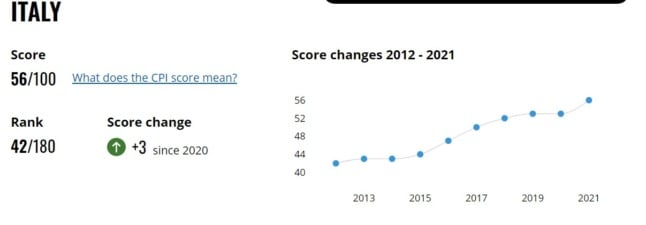Italy once again ranked among the most corrupt countries in Europe on the 2021 Corruption Perceptions Index (CPI) released by anti-corruption campaign group Transparency International on Tuesday.
The index ranks 180 countries and territories around the world by their perceived levels of public sector corruption. The results are given on a scale of 0 (highly corrupt) to 100 (very clean).
Italy’s score of 56/100 puts it 42nd out of 180 countries on the list, and among the countries in the European Union perceived as most corrupt along with Slovenia (which scored 57) and Poland (56).
Ranked worst among all European Union member states was Hungary, at 43rd place with a score of 53.
The index ranks 180 countries and territories by their perceived (not actual) levels of public sector corruption, using a scale of 0 to 100, where 0 is highly corrupt and 100 is very clean.
READ ALSO: Venetians protest cruise ships and corruption after historic flooding
Though Italy has long been perceived as one of the most corrupt countries in Europe, the latest edition of the annual study shows things have in fact improved again this year.
Italy has improved its ranking by three points since scoring 53/100 in last year’s index.
The rankings show improvement over the past decade, as Italy ranked 42nd on the list in 2012.

Transparency International said in its report that Italy’s improvement this year “is the result of the growing attention paid to the problem of corruption in the last decade, and bodes well for the country’s economic recovery after the crisis generated by the pandemic”.
Italy had “reaped the rewards of anti-corruption reforms” over the past year, it said, while stressing that it remains among the European region’s low scorers.
“Legislative gaps need to be urgently filled for lobbying and beneficial ownership in Italy,” Transparency International said.
According to the report, Italians believe the two most corrupt institutions in the country are political parties and parliament itself.
At the top of the table, Denmark, New Zealand and Finland share the desirable position of world’s least corrupt country, followed by Norway and Singapore.
Sweden, Switzerland, the Netherlands, Luxembourg and Germany complete the top 10.
With an average score of 66 out of 100, Western Europe and the EU still tops the CPI but progress in recent years has plateaued, the report stated.
“Countries in Western Europe and the European Union continue to wrestle with transparency and accountability in their response to Covid-19, threatening the region’s clean image,” Transparency International writes.
The organisation on Tuesday predicted “trouble ahead for the stagnating region”.
Countries with well-protected civil liberties generally score higher on the CPI, while countries who violate civil liberties tend to score lower, Transparency International writes.
READ ALSO: 12 statistics that show how the pandemic has hit Italy’s quality of life
But even at the top end of the index, countries are failing to improve their records on public sector corruption, according to the report.
The index also noted that the Covid-19 pandemic had been used in some countries as an excuse to “curtail basic freedoms and side-step important checks and balances”.
“In authoritarian contexts where control rests with a few, social movements are the last remaining check on power. It is the collective power held by ordinary people from all walks of life that will ultimately deliver accountability,” CEO Daniel Eriksson said on the Transparency International website.
According to the index, 131 countries have made no significant progress against corruption in the last decade. Two-thirds of countries scored below 50, indicating that they have serious corruption problems, while 27 countries are at their lowest score ever.
The Corruption Perceptions Index is the most widely-used global corruption ranking in the world and measures how corrupt experts and businesspeople perceive each country’s public sector to be, based on a minimum of three data sources drawn from institutions including the World Bank and the World Economic Forum.
It does not relate to corruption in the private sector, including money laundering and tax fraud.



 Please whitelist us to continue reading.
Please whitelist us to continue reading.
Member comments